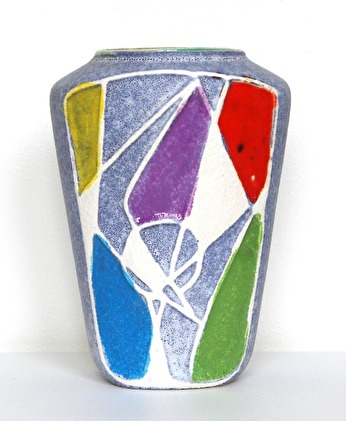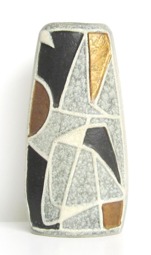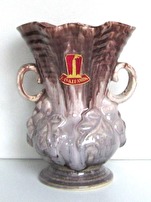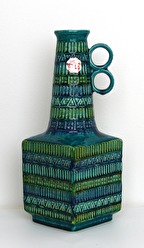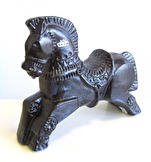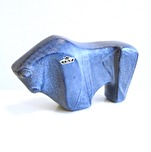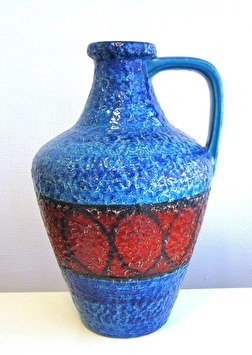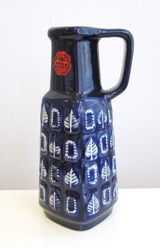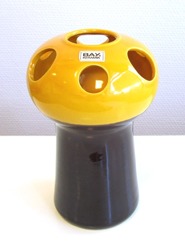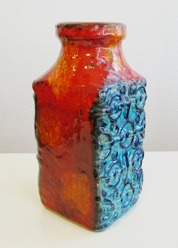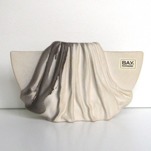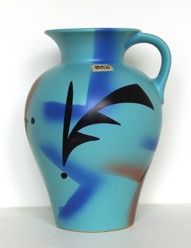Bay 1933-1997
History
Bay (Eduard Bay Keramikfabrik) was founded by Eduard Bay in 1933 in Ransbach Baumbach. Originally, table ceramics and cooking pots were produced in unglazed terracotta. In 1937 new technology was introduced with molds, which meant faster production and more consistent quality. After a break in the production at the end of World War II, production was resumed. More decorative ceramics began to be produced in the early 50's. Manufacturing and sales increased rapidly and in the early 60's Bay was one of the leading manufacturers of art ceramics. According to some sources, Bay stopped manufacture art ceramics in 1971 to focus entirely on the production of a patented cooking pan with lid under the name "Römertopf". However, there are evidence that the production of art ceramics continued into the early 90's. Bay ended in 1997 when new owners took over the brand and renamed the company to "Römertopf Keramik GmbH".
Shapes and decors
Early Bay forms from the 30s, 40s and early 50s are inspired by the Jugend/Art Nouveau style with moulded patterns of natural forms like leafs and flowers. The colours are discreet in gray, brown and green palettes. Some decors have small spots in orange containing uranium.
In the mid 50s painted geometric patterns became popular. One example is the decor "Florenz" from 1955. In the late 50s and early 60s the colours schemes in the geometric patterns became more advanced and more colorful.
At the end of the 60s and in the early 70s Bay introduced many forms with moulded patterns. In combination with strong colours many of these forms are very decorative and represent the best ceramics that Bay produced. Examples of this is a serie designed by Bodo Mans named Ravenna (1961), Istanbul (1961), Iberia (1962) and Bristol (1962). Another series with moulded geometric patterns are the forms 70 14, 70 20, 70 25, 70 45, 71 17, and 71 35 from the period
ca. 1969 - ca. 1972. These vases are often wrongly attributed to Bodo Mans, however the designer is still unknown.
From the end of the 60s and the early 70s is a series of figurines. Four figurines are known; A woman with a fruit basket, a horse , an elephant and a bull. The designer is not known. These figurines are not marked.
Bay 1031 -17. Decor Bristol presented 1962. Design Bodo Mans.
Designers
Bodo Mans 1959-1975
Josef Koch 1967-1988
A Seide
Ludwig (Lu) Klopfer
Bay 1032 20. Decor Iberia presented 1962. Design Bodo Mans.
Bay 1058. The decor is inspired by the Jugend/Art Nouveau style.
The handle has a orange colour containing Uranium.
Bay 285 17. This vase is inspired by the Jugend/Art Nouveau style. Bay produced probably this type of vases from the start 1933 but continued with this style into the 50s.
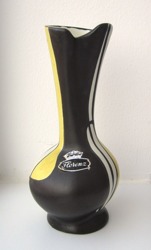
Bay 541 17, decor Florenz presented 1955. Typical mid 50s form and decor.
Bay 71 35. Decor Scandia from the "Töpfermeister" series. This is an example of a very advanced form with a molded pattern. This piece from
ca. 1969-ca. 1972.
Note: The designer is not Bodo Mans.
During the 70s Bay continued to produce ceramics with moulded patterns, often with natural inspired forms like leafs. Extreme fat lava glazes are not so common but can be a part of the decoration in combination with moulded patterns.
The forms 96 12, 96 17 and Bay 96 20 are example of a mushroom-like form from the mid 70s. This form may have been inspired by the Russian spacecraft Soyuz.
Bay continued to produce art ceramics under the 80s and at least some years after the reunion of Germany 1990. They made some interesting forms but stopped producing ceramics with moulded patterns and colorful, vibrant glazes. These late ceramics are less interesting for collectors today.
Bay 218 50. A very large floor vase. Late 60s - early 70s.
Bay 250 25. The moulded pattern is inspired by natural forms like leafs. Decor Seine presented 1968.
Bay 984 20 from the end of the 60 -early 70s. This vase has a moulded pattern, probably inspiered by Keltic symbols, on two sides and a thick colorful glaze on the other two sides.
